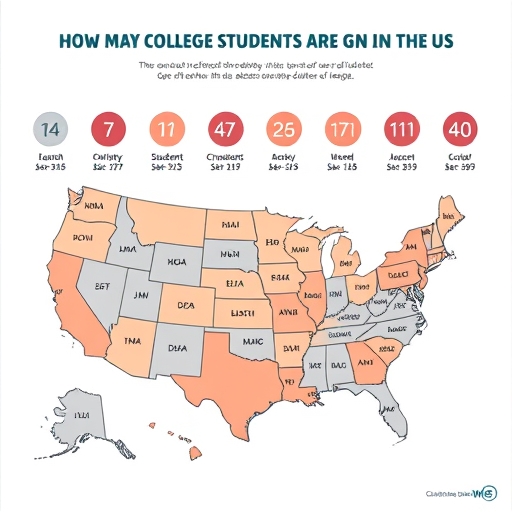How Many College Students Are in the U.S.?
The landscape of higher education in the United States is vast and ever-changing. With millions of students pursuing various degrees across thousands of institutions, understanding the number of college students in the U.S. can provide insight into trends in education, workforce development, and societal shifts. This article aims to explore the current statistics, factors influencing enrollment, and the implications of these numbers.
Overview of College Enrollment in the U.S.
As of the latest data, there are approximately 19.7 million students enrolled in colleges and universities across the United States. This figure encompasses a wide range of educational institutions, including:
- Public four-year colleges and universities
- Private non-profit colleges
- Private for-profit colleges
- Community colleges
- Post-WWII Boom: The G.I. Bill significantly increased enrollment in the late 1940s and early 1950s.
- 1980s and 1990s: A steady increase in enrollment due to a growing emphasis on higher education.
- 2008 Financial Crisis: A surge in enrollment in community colleges as individuals sought to improve their skills during economic downturns.
- Recent Years: A slight decline in enrollment in some sectors, particularly in for-profit colleges, as a result of increased scrutiny and changing perceptions.
- Diverse Student Population: The demographics of college students are increasingly diverse, with a growing number of minority students and international students.
- Online Learning: The rise of online education has made higher education more accessible, contributing to enrollment growth, especially during the COVID-19 pandemic.
- Adult Learners: A significant number of students returning to education later in life, often to reskill or change careers.
- Job Market: Strong job markets often lead to decreased enrollment as students may choose to enter the workforce instead.
- Tuition Costs: Rising tuition costs can deter potential students, particularly from low-income backgrounds.
- Population Growth: An increase in the population of high school graduates can lead to higher college enrollment rates.
- Diversity: An increasing focus on diversity and inclusion has encouraged more students from various backgrounds to pursue higher education.
- Government Funding: Changes in federal and state funding for higher education can impact college affordability and access.
- Student Loan Policies: The availability and terms of student loans can significantly influence students’ decisions to pursue higher education.
- Changing Attitudes: Societal perceptions of the value of a college degree can shift, influencing enrollment rates.
- Workforce Needs: As industries evolve, the demand for skilled workers can encourage more individuals to seek higher education.
- Initial Decline: In 2020, college enrollment dropped by 4.5% compared to the previous year, with community colleges experiencing the most significant declines.
- Shift to Online Learning: Many institutions adopted remote learning, which changed the landscape of education and enrollment.
- Resilience and Recovery: As institutions adapted, enrollment began to stabilize, with many students returning for in-person classes in subsequent semesters.
- Hybrid Learning Models: The integration of online and in-person instruction is likely to continue, offering more flexible options for students.
- Increased Focus on Skills-Based Education: Programs that offer practical skills and certifications may attract more students, especially in fields facing worker shortages.
- Continued Diversity Efforts: Institutions will likely ramp up efforts to recruit and support underrepresented students.
- Business
- Health Professions
- Social Sciences
- Engineering
- Education
Breakdown of Enrollment by Institution Type
| Institution Type | Enrollment (Approx.) |
|---|---|
| Public Four-Year Colleges | 12.4 million |
| Private Non-Profit Colleges | 3.1 million |
| Private For-Profit Colleges | 1.1 million |
| Community Colleges | 3.1 million |
Trends in College Enrollment
Historical Context
The number of college students in the U.S. has seen significant fluctuations over the years, influenced by various social, economic, and political factors. Here are some key historical trends:
Current Enrollment Trends
Factors Influencing College Enrollment
Several factors can influence the number of students enrolling in colleges and universities, including:
Economic Conditions
Demographic Shifts
Policy Changes
Social Trends
The Impact of COVID-19 on College Enrollment
The COVID-19 pandemic had a profound impact on college enrollment trends:
The Future of College Enrollment
As we look ahead, several trends may shape the future of college enrollment:
Frequently Asked Questions (FAQ)
How many colleges and universities are there in the U.S.?
There are approximately 4,000 degree-granting postsecondary institutions in the United States, including both public and private colleges.
What is the average age of college students in the U.S.?
The average age of college students varies, but traditional students (those attending right after high school) are typically around 18-19 years old. However, many adult learners return to education, raising the average age to around 24 years.
What percentage of high school graduates go to college?
Approximately 66% of high school graduates enroll in college immediately after graduation. This percentage can vary based on socioeconomic factors and geographic location.
Are online colleges considered in the enrollment figures?
Yes, online colleges and programs are included in the overall enrollment figures, as many traditional institutions offer online courses and degrees.
What are the most popular fields of study among college students?
Some of the most popular fields of study include:
Conclusion
Understanding how many college students are in the U.S. is crucial for grasping the broader trends in education and workforce development. With approximately 19.7 million students enrolled, the landscape is shaped by a variety of factors, including economic conditions, demographic shifts, and evolving societal attitudes toward education. As we look to the future, the trends emerging from the COVID-19 pandemic and ongoing changes in the job market will likely continue to influence college enrollment patterns.
In this dynamic educational environment, institutions must adapt to meet the needs of a diverse and evolving student population, ensuring that higher education remains accessible and relevant in the years to come.





